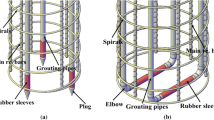Abstract
Slime forms at the bottom of boreholes under the effect of groundwater. The larger the borehole, the more the slime. The demand for large-diameter cast-in-place (CIP) piles has increased as the number of large structures has increased. Excessive slime management can delay construction. However, the effect of slime on the engineering characteristics of large-diameter CIP piles is not understood. In this study, the strength of slime-concrete mixtures was investigated by varying the volume ratio of slime. Field-scale testing was performed to evaluate the behavior of the large-diameter CIP pile using bidirectional load testing. A numerical analysis was performed to assess the compressibility of the slime under the self-weight of the pile. The results revealed that the general levels of slime at the bottom of the borehole had an insignificant influence on the engineering characteristics of the large-diameter CIP pile because the slime is susceptible to being mixed with poured concrete and compressed by the self-weight of the pile.
Similar content being viewed by others
References
AASHTO (2017) LRFD Bridge construction specifications, 4th edition. American Association of State Highway and Transportation Officials, Washington DC, USA
ASTM D854–14 (2014) Standard test methods for specific gravity of soil solids by water pycnometer. ASTM D854-14, ASTM International, West Conshohocken, PA, USA
ASTM D2487-17e1 (2017) Standard practice for classification of soils for engineering purposes (unified soil classification system). ASTM D2487-17e1, ASTM International, West Conshohocken, PA, USA
ASTM D4318-17e1 (2017) Standard test methods for liquid limit, plastic limit, and plasticity index of soils. ASTM D4318-17e1, ASTM International, West Conshohocken, PA, USA
ASTM D8169M-18 (2018) Standard test methods for deep foundations under bi-directional static axial compressive load. ASTM D8169M-18, ASTM International, West Conshohocken, PA, USA
Bang JW, Park CK, Yang SY, Kim YY (2016) Flexural behavior of large-diameter composite PHC pile using in-filled concrete and reinforcement. Journal of the Korea Institute for Structural Maintenance and Inspection 20(5):109–115, DOI: https://doi.org/10.11112/jksmi.2016.20.5.109
Bowles LE (1996) Foundation analysis and design. McGraw-Hill Education, New York, NY, USA
Chen XY, Shen J, Zhu J, Wang W, Qian DG (2008) Design of ultrasonic drilling monitor system. Instrument Technique and Sensor 5
Chun OH, Yoon HK, Park MC, Lee JS (2014) Slime thickness evaluation of bored piles by electrical resistivity probe. Journal of Applied Geophysics 108:167–175, DOI: https://doi.org/10.1016/j.jappgeo.2014.07.004
Das BM (2015) Principles of foundation engineering. Cengage Learning, Boston, MA, USA
Ding JZ, McIntosh KA, Simon RM (2015) New device for measuring drilled shaft bottom sediment thickness. Journal of the Deep Foundations Institute 9(1):42–47, DOI: https://doi.org/10.1179/1937525515Y.0000000004
Gao L, Yang K, Chen X, Yu X (2017) Study on the deformation measurement of the cast-in-place large-diameter pile using fiber bragg grating sensors. Sensors 17(3):505, DOI: https://doi.org/10.3390/s17030505
Ho R (1982) Development of a shaft inspection device. Transportation Research Board 102
Hong WT, Woo G, Park MC, Lee JS (2020) Slime-meter for assessment of slime thickness based on electrical properties in borehole. Automation in Construction 119:103328, DOI: https://doi.org/10.1016/j.autcon.2020.103328
Jun S, Park B, Lee H, Yoo N, Moon M (2009) Engineering characteristics of slime generated by application of deep mixing method. Journal of the Korean Geo-Environmental Society 10:99–103
Lam C, Jefferis SA, Martin CM (2014) Effects of polymer and bentonite support fluids on concrete-sand interface shear strength. Geotechnique 64(1):28–39, DOI: https://doi.org/10.1680/geot.13.P.012
Lee JH, Cho JW, Do J, Park B (2017) Evaluation of field applicability of cast-in-place piles using surfactant grout. Key Engineering Materials 744:207–213, DOI: https://doi.org/10.4028/www.scientific.net/KEM.744.207
Moghaddam RB, Hannigan PJ, Anderson K (2018) Quantitative assessment of drilled shafts base-cleanliness using the shaft quantitative inspection device (SQUID). Proceedings of IFCEE 2018, March 5–10, Orlando, FL, USA
Poulos HG (2016) Tall building foundations: Design methods and applications. Innovative Infrastructure Solutions 1(1), DOI: https://doi.org/10.1007/s41062-016-0010-2
Prakash S, Sharma HD (1990) Pile foundations in engineering practice. John Wiley & Sons, Hoboken, NJ, USA
Schmertmann JH, Hayes JA, Molnit T, Osterberg LO (1998) O-cell testings case histories demonstrate the importance of bored pile (drilled shaft) construction technique. Proceedings of 4th international conferences on case histories in geotechnical engineering, March 8–15, St. Louis, MO, USA
Acknowledgments
Funding from Gyeongsang National University Office of Academy and Industry Collaboration and Marine Industry Research Center is appreciated. We would like to thank Editage (www.editage.co.kr) for English language editing.
Author information
Authors and Affiliations
Corresponding author
Rights and permissions
About this article
Cite this article
Heo, O., Yoon, Y. & Do, J. Effect of Slime on Engineering Characteristics of Large-Diameter Cast-in-Place Pile. KSCE J Civ Eng 26, 88–95 (2022). https://doi.org/10.1007/s12205-021-0343-z
Received:
Revised:
Accepted:
Published:
Issue Date:
DOI: https://doi.org/10.1007/s12205-021-0343-z




